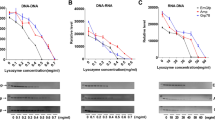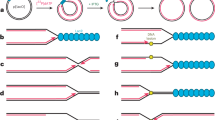Abstract
Because peptide nucleic acids (PNAs) are capable of blocking amplification of deoxyribonucleic acid (DNA) by Taq DNA polymerase in vitro, we postulated that PNAs might be able to block replication in vivo. To explore this possibility, we assessed the ability of PNA to specifically block the replication of pUC19 plasmids by allowing a PNA, directed against segments of the Amp r sequence to bind to pUC19 prior to electroporation into Escherichia coli, strain DH10B. Colonies produced by this maneuver not only remained sensitive to ampicillin but were also incapable of blue color production on X-gal-containing media, thus demonstrating true blockade of pUC19 replication, rather than antisense activity. The ability of the PNA to prevent pUC19 replication in these experiments was shown to be dose related.
Attempts to prevent the replication of E. coli using a PNA directed against a portion of the lac Z sequence found within the bacterial genome were not uniformly successful. Subsequent experiments showed that the electroporated PNA did not consistently enter a sufficient number of cells for an effect to be demonstrated in the assays used.
Nonetheless, this is the first demonstration of in vivo complete replication blockade by a PNA and opens up the potential for new forms of specific antibiosis in both prokaryotic and eukaryotic cells.
Similar content being viewed by others
References
Iyer, M., Norton, J. C., and Corey, D. R. (1995) Accelerated hybridization of oligonucleotides to duplex DNA. J. Biol Chem. 270, 14,712–14,717.
Knudsen H. and Nielsen, P. E. (1997) Application of peptide nucleic acid in cancer therapy. Anticancer Drugs 8, 113–118.
Shammas, M. A., Simmons, C. G., Corey, D. R., and Reis, R. J. S. (1999) Telonerase inhibition by peptide nucleic acids reverses “immortality” of transformed human cells. Oncogene 18, 6191–6200.
Larsen, H. J. and Nielsen, P. E. (1996) Transcription-mediated binding of peptide nucleic acid (PNA) to double-stranded DNA: sequence-specific suicide transcription. Nucleic Acids Res. 24, 458–463.
Boffa, L. C., Morris, P. L., Carpaneto, E. M., Louissaint, M., and Allfrey, V. G. J. (1996) Invasion of the CAG triplet repeats by a complementary peptide nucleic acid inhibits transcription of the androgen receptor and TATA-binding protein genes and correlates with refolding of an active nucleosome containing a unique AR gene sequence. Biol. Chem. 271, 13,228–13,233.
Ørum, H., Nielsen, P. E., Egholm, M., Berg, R. H., Buchard, O., and Stanley, C. (1993) Single base pair mutation analysis by PNA directed PCR clamping. Nucleic Acids Res. 21, 5332–5336.
Taylor, R. W., Chinnery, P. F., Turnbull, D. M., and Lightowlers, R. N. (1997) Selective inhibition of mutant human mitochondrial DNA replication in vitro by peptide nuicleic acids. Nat. Genet. 15, 212–215.
Boffa, L. C., Carpaneto, E. M., Mariani, M. R., Louissaint, M., and Allfrey, V. (1997) Contrasting effects of PNA invasion of the chimeric DMMYC gene on transcription of its myc and PVT domains. Oncol. Res. 9, 41–51.
Tyler, B. M., Jansen, K., McCormick, D. J., et al. (1999) Peptide nucleic acids targeted to the neurotensin receptor and administered i.p. cross the blood-brain barrier and specifically reduce gene expression. Proc. Natl. Acad. Sci. USA 96, 7053–7058.
Faruqi, A. F., Egholm, M., and Glazer, P. M. (1998) Peptide nucleic acid-targeted mutagenesis of a chromosomal gene in mouse cells. Proc. Natl. Acad. Sci. USA 95, 1398–1403.
Horton, R. M. (1993) In vitro recombination and mutagenesis: SOEing together tailor-made genes. In Methods in Molecular Biology, vol. 15: PCR Protocols: Current Methods and Applications (White, B. A., ed.), Humana Press, Totowa, NJ, pp. 251–261.
Jou, N-T., Yoshimori, R. N., Mason, G., Louie, J. S., and Liebling, M. R. (1997) Single tube, nested reverse transcriptase polymerase chain reaction for the detection of viable Mycobacterium tuberculosis. J. Clin. Microbiol. 36, 1161–1165.
BRL Life Technologies Cell-Porator Voltage Booster Catalog Series 1612. (1991) Life Technologies, Grand Island, NY, pp. 3–11.
Sambrook, J., Fritsch, E. F., and Maniatis, T. (1989) Molecular Cloning A Laboratory Manual, 2nd ed., Cold Spring Harbor Press, Cold Spring Harbor, NY, pp. 1.86 and 4.22.
Hanvey, J. C., Peffer, M. J., Bisi, J. E., et al. (1992) Antisense and antigene properties of peptide nucleic acids. Science 258, 1481–1485.
Bentin, T. and Nielsen, P. E. (1996) Enhanced peptide nucleic acid binding to supercoiled DNA: possible implications for DNA breathing. Biochemistry 35, 8863–8869.
Sniden, R. R., Carlson, J. O., and Pettijohn, D. E. (1980) Torsional tension of DNA double helix measured with trimethylpsoralen in living E. coli cells: analagous measurements in insect and human cells. Cell 21, 773–783.
Griffith, M. C., Risen, L. M., Greig, M. J., et al. (1995) Single and bis peptide nucleic acids as triplexing agents: binding and stoichiometry. J. Am. Chem. Soc. 117, 831–832.
Good, L. and Nielsen, P. E. (1998) Antisense inhibition of gene expression in bacteria by PNA targeted to mRNA. Nat. Biotechnol. 16, 355–358.
Good, L., Anasthi, S. A., Dryselius, R., Larson, O., and Nielsen, P. E. (2001) Bactericidal antisense effects of peptide-PNA conjugates. Nat. Biotechnol. 19, 360–364.
Aldrian-Herrada, G., Desarmenian, M. G., Orcel, H., et al. (1998) A peptide nucleic acid (PNA) is more rapidly internalized in cultured neurons when coupled to a retroinverso delivery peptide: the antisense activity depresses the target mRNA and protein in magnocellular oxytocin neurons. Nucleic Acids Res. 26, 4910–4916.
Pooga, M., Soomets, U., Hällbrink, M., et al. (1998) Cell penetrating PNA constructs regulate galanin receptor levels and modify pain transmission in vivo. Nat. Biotechnol. 16, 857–861.
Mologni, L., Marchesi, E., Nielsen, P. E., and Gambacorti-Passerine, C. (2001) Inhibition of promyelocytic leukemia (PML)/retinoic acid receptor-a and PML expression in acute promyelocytic leukemia cells by anti-PML peptide nucleic acid. Cancer Res. 61, 5468–5473.
Liebling, M. R., Jou, N-T., Green, L., Colburn, K. K., Waldman, W. J., and Louie, J. S. (2001) Intracellular targeting of peptide nucleic acids mediated by cationic liposomes (Oligofectamine™) and anti-guanosine antibody. Submitted for presentation at the National Meetings of the ACR, 2002.
Author information
Authors and Affiliations
Corresponding author
Rights and permissions
About this article
Cite this article
Liebling, M.R., Jou, NT., Fang, W. et al. Blockade of plasmid replication mediated by peptide nucleic acids. Mol Biotechnol 25, 229–240 (2003). https://doi.org/10.1385/MB:25:3:229
Issue Date:
DOI: https://doi.org/10.1385/MB:25:3:229




